I arrived in the Mara in early January to a landscape completely transformed from the one that I had encountered on my previous two trips in August and September last year. Back then, the whole of Kenya had been in the grip of a prolonged drought. An unrelenting heat bore down from cloudless skies, parching the land and cloaking it in a veil of dusty brown. As water sources dried up and as the vegetation withered, so too did the animals. Northern Kenya and in particular, its elephant population, was especially hard hit with normally reliable rivers reduced to scorched, cracked fingers of dust. While water levels were significantly down on usual levels, the Mara River continued to flow, allowing the area’s wildlife to cling on, assuming they still processed sufficient nimbleness to escape the clutches of the river’s voracious crocodile population.
In December the rains arrived. Following a deluge lasting several days, which saw the previous bone dry, black-cotton soil that covers the Mara taking on a consistency of gooey chocolate, the landscape morphed into a verdant green. The Talek River – the Mara’s other major water source – which as recently as November had been no more than trickle had now risen to a level making vehicle crossings impossible, thereby necessitating lengthy detours.
Although the migration herds are absent at this time of the year, having moved south to the breeding and calving expanses of the Serengeti in Tanzania, the usual array of predators and game were all on full display along with various additional players not usually seen during migration season. Another bonus was the virtual absence of vehicles, in marked contrast to the peak season months. While this made finding animals a little more difficult, the reward was that once found, you could often be on your own with them for long periods.
For thirteen years I have hoped to photograph the elusive Caracal. Once, three years ago, I had a brief encounter with one as night was falling, but it was a daylight encounter that I longed for.
Caracals are not only almost exclusively nocturnal but are incredibly shy and tend to inhabit areas characterized by long grass – all of which makes a good day time sighting extremely rare.
In October, I received word that a family of Caracals were being seen regularly in an area not far from where we camp so I was hopeful that on this trip I would run into this most secretive of cats.
Early in the trip after arriving back at camp one evening, we received a radio call that a Caracal had been seen just outside the entrance of the camp. Grabbing a camera, we rushed into our vehicle and sure enough, no more than 50 meters away was an adult Caracal, out in the open and showing none of the shyness that it is renowned for. In the gathering gloom of twilight, I took some half way decent images at ISO 1,600 and 1/25th of a second (camera technology is pretty amazing these days: a few of the pics were sharp with acceptable levels of grain).
After a fruitless search early the next morning, we moved off to a neighboring area when we received a call from a friendly Italian guide (thanks Federico) that he had been following two adult Caracals since dawn. Within a few minutes, I had my first daylight sighting, and shortly thereafter, my first photos.
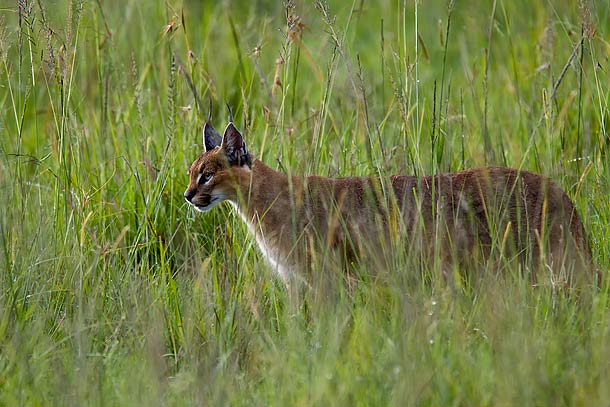
Over the course of the next few hours we followed the two feline beauties as they flitted in and out of the grass cover. So stealthy are they that it is very easy to lose sight of them if you take your eyes off them for even a few moments. Caracals are cryptically coloured except for the head, which is boldly marked and surmounted by remarkably conspicuous ears, white on the inside and black on the outside, with black tufts, so that every twist, turn and flick is clear to see.
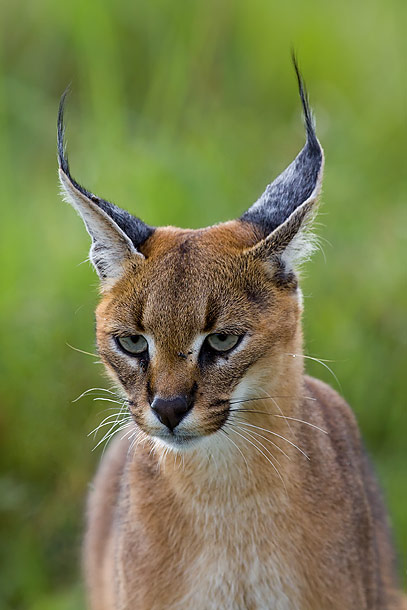
After briefly losing sight of our pair, one of them suddenly emerged briefly, holding a Scrub Hare in its jaws. I practically wet myself! Whether it had been killed there and then or had been stashed away for some time was unclear. Simon, our amazing Masai guide and driver desperately tried to get us into a position for a photo but alas we were thwarted by a combination of the long grass and the Caracal dropping the intact carcass into a deep burrow.
For the next two hours, the two cats spent the time periodically eating, resting and occasionally slinking off to drink. The latter activity necessitated passing through one of the few unobstructed areas. This individual kindly stopped briefly to pose for us.
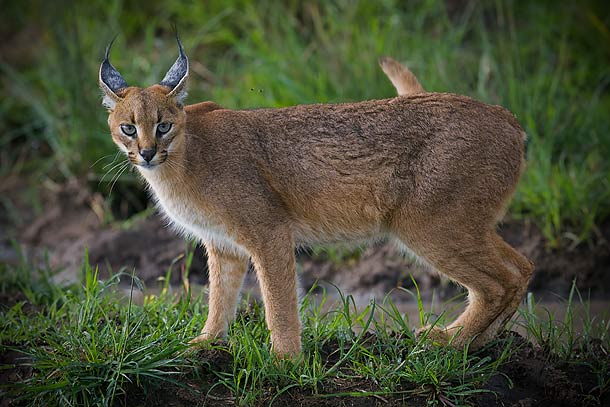
With one of my long held wishes now fulfilled and with this encounter having effectively made the trip, I was able to take the view that everything else on the trip should be treated as a bonus.
As always we spent a fair bit of time with other members of the cat family. The Ol Kiombo pride of lions has split up and is scattered along both banks of the Talek River. The Lionesses on each side all have young cubs and we endeavored to find them on a number of mornings, with mixed success. Having been awake for most of the night, the mothers want nothing more than to sleep all day. The cubs on the other hand only have play and suckling on their minds. As always, there were some wonderfully candid moments between the mothers and their offspring.
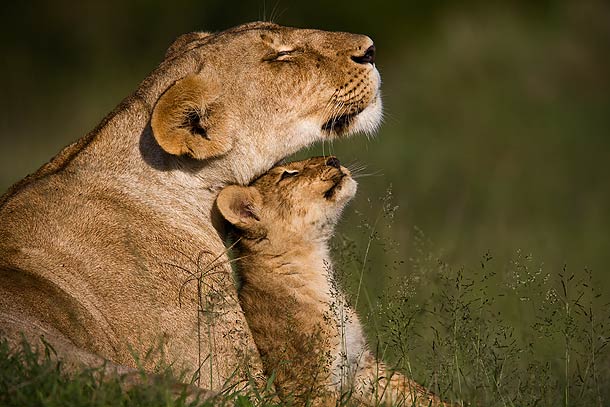
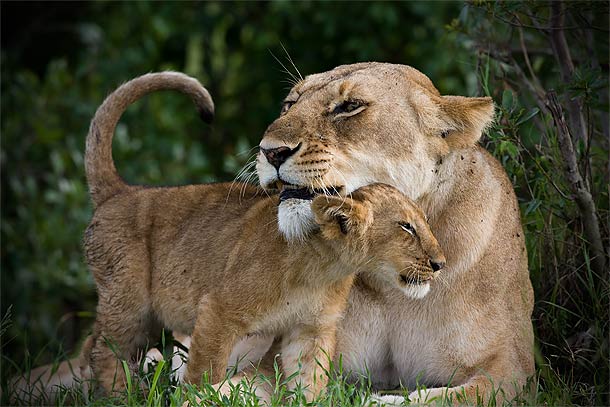
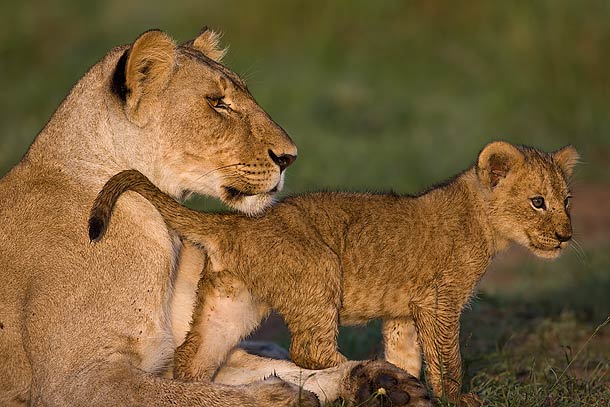
With prey relatively scare vs the migration season, the cats were forced to do more diurnal hunting than usual. They also were forced to tackle game that they would normally pass over during the more bountiful months. Top of the menu was Warthog. On the face of it, the Warthog looks to be no match for a large cat. Yet it has a surprising turn of pace and the adults have a set of tusks which even the largest of cats needs to be wary of. Moreover, the plains of the Mara are dotted with borrows, hollowed out by a variety of species including Warthogs themselves as well as Hyenas, Jackals, Bat-Eared Foxes and Mongooses. These provide a convenient destination of refuge in the face of advancing predators.
However, as we were to discover, the cats were to prove extremely resourceful when faced with this seemingly insurmountable obstacle.
Late one afternoon, we watched three Lionesses stalk a sub-adult Warthog in the long grass. After a long build-up, one of the Lionesses had managed to get within striking distance without being detected. In a flash she burst out of the curtain of grass, the muscles in her hind quarters straining. The gap had closed to 20 meters before the Warthog realized its predicament. The distance between prey and predator was now such that the Warthog, with the disadvantage of a standing start, had little hope of outpacing the Lioness. Just as it seemed the Warthog must be doomed, it disappeared down a burrow.
The Lioness came to an abrupt halt. The opening was only large enough to accommodate the front half of the Lionesses’ face and this was clearly a deep burrow with the Warthog now deeply ensconced inside. Normally that would have been it with the Lioness admitting defeat. But this was clearly a hungry cat, as were her two companions, who soon joined her.
And so the digging began. Clumps of earth flew up behind the front paws of the cats as the entrance was progressively enlarged. Periodically one of the Lionesses would thrust her face and jaws deep into the burrow in a frenzy of movement. One can only imagine the sheer terror that the Warthog was experiencing as the huge canines of its marauders inched ever closer.
This process lasted for the better part of thirty minutes. Sitting in the vehicle 10 meters away, we began to lose interest to the point where we had lowered our cameras. Just when it seemed that the Warthog would live to fight another day, there was a flurry of movement accompanied firstly by deep growling and then by high pitched squealing. Suddenly one of the Lionesses emerged with its jaws clamped around the Warthog’s windpipe. With the Warthog still very much alive and struggling desperately to extricate itself, the Lioness took off in a gallop anxious to avoid sharing its meal with the others.
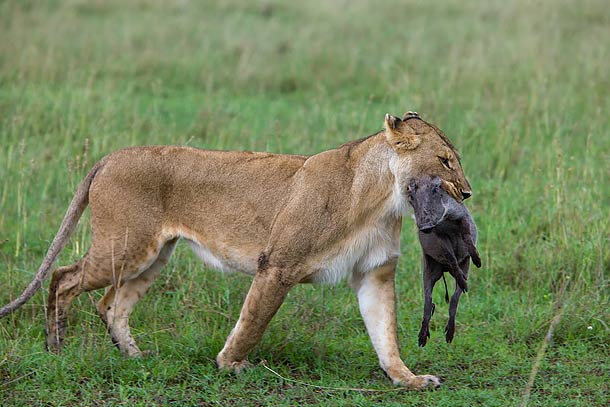
After much chasing, the other two Lionesses eventually cornered the Lioness and her quarry. Thankfully the end was swift for the Warthog with all three Lionesses simultaneously administering the final death choke. One sub-adult Warthog however, represents now more than a small appetizer when shared amongst three fully grown Lionesses meaning that they would inevitably be forced into more hunting later that night.
The next day we witnessed a near replicate performance, only this time involving three male Cheetahs and a fully grown Warthog. These were the same three boys that I had spent many hours with over the previous two years and were the ones that featured in the dramatic images when they “kidnapped” a female and aggressively courted her in trying to ascertain whether she was on heat (see the: Animal Behavior, Mammals, section in the gallery section of www.wildencounters.net).
Anyway, after an extended chase by one of the boys, the Warthog disappeared down a burrow. Again, a long period of digging ensued. Eventually, the Warthog was flushed out. But with its flashing tusks, the Cheetahs struggled to get near its throat. One of them however, had firmly sunk its teeth into the Warthog’s back leg. With the Warthog now partially immobilized, the other two moved in for the kill.
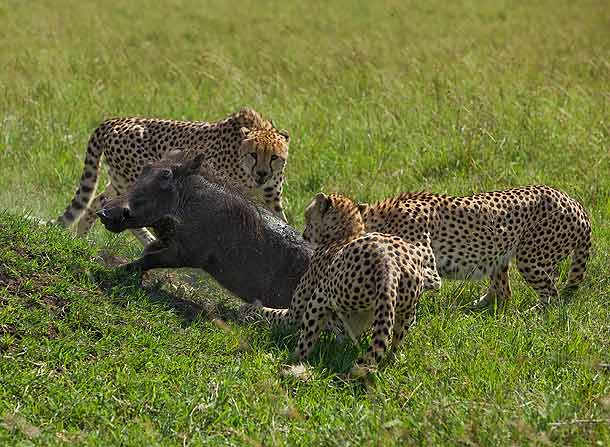
As one climbed onto the Warthog’s back, the other twisted its head underneath the neck before clamping down on the throat. But the skin around a Warthog’s throat is thick and leathery making the process of strangulation difficult for a cat with relatively small jaws.
With its golden eyes blazing and its rump heaving, the Cheetah crunched down with maximum effort. The tables were turning and with the Warthog’s air supply chocked off, death appeared an inevitability.
However, alerted by the Warthog’s desperate squealing, a Spotted Hyena suddenly appeared bounding towards the melee in pursuit of an easy meal. Hyenas are master scavengers and whenever possible will select the most easily captured prey. The crushing power of a Hyena’s jaws surpasses that of any of the other cat family members, including lions, and in a fight, Cheetahs would stand little chance. The three boys quickly took flight leaving the Hyena face to face with a groggy looking Warthog.
However, after the briefest of moments and despite a deep bite wound to one of its upper legs, the Warthog took off at top speed seemingly none the worse for its near death experiencing. Perhaps because it was unaccompanied by other clan members; perhaps because it had recently eaten, the Hyena showed no interest in expending any effort to catch the Warthog and sauntered off in the direction it had come from.
A few days later we came upon an adult female cheetah with a sub-adult cub. We had only been with them a few minutes when the mother suddenly stopped, its eyes focused on movement at the edge of a distant river bank. Almost immediately she broke into a trot, gradually accelerating to full speed. A Thomsen’s Gazelle had crossed the river and had been spotted by the Cheetah as it exited the river bank. The Gazelle failed to see the Cheetah until the very last moment by which time it was too late for it to get up any head of speed. The Cheetah tripped the Gazelle’s back legs, sending it sprawling in a swirl of mud and flying grass and almost as quickly, the Cheetah had locked its jaws around the fragile windpipe of the Gazelle.
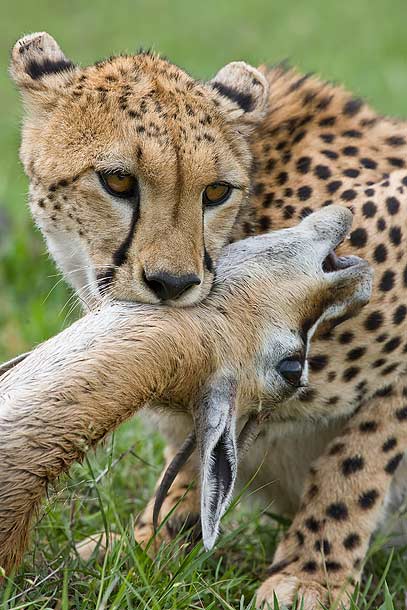
Clearly hungry, the cub did not even wait for its mother to release her strangle hold, tucking into the hind rump of the Gazelle.
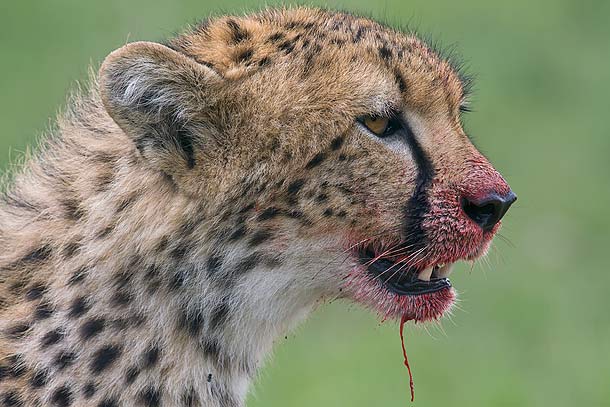
Photography is partly about experimentation; about pushing boundaries and trying new techniques. The advent of the digital era has meant that it is increasingly hard to produce images that are different. One of the simple techniques that I have been looking to exploit is to get really low when shooting images. By this, I mean right down into the grass so that one is actually shooting up at subjects. To do so produces a much more intimate image. While physically lying in the grass may work in certain circumstances, a number of animal species are either too dangerous or too shy to effectively employ this technique. I have recently had a number of “rock cams” made in China, ie cameras encased in rock like structures with the shutter triggered manually be a wireless transmitter. At the time of this trip, these were not yet ready. However, as a stop gap, I took a monopod to the end of which I attached a camera which in turn had an infrared trigger attached to it. By holding and lowering the monopod out of the vehicle, and by using a wide-angle lens, I was able to produce a series of “bugs eye” images of various animals.
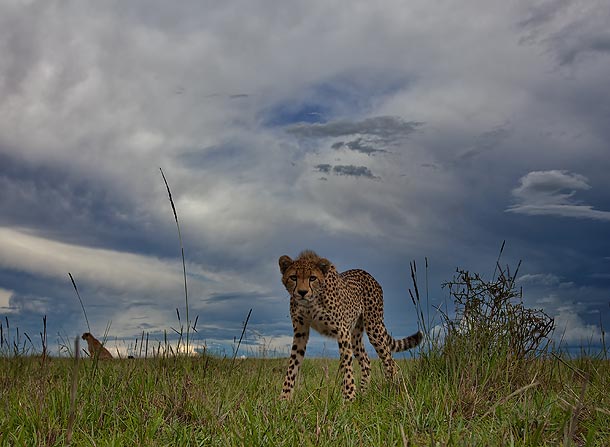
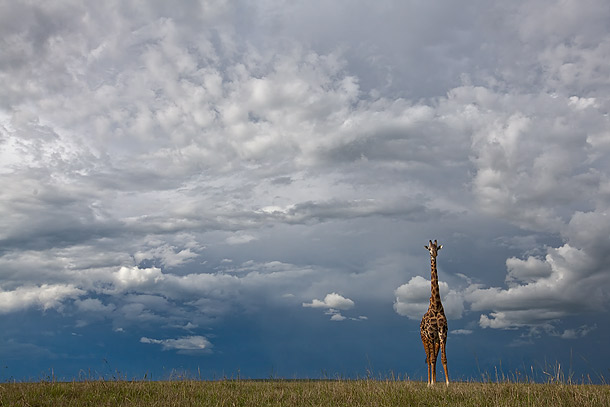
I was able to try out the rock cams with some success recently on snow monkeys in Japan but I am really looking forward to seeing what I can get when I go to the Serengeti in May.
During the wet season in Kenya, many avian species are either more abundant or engaged in activities which you cannot witness at other times of the year. Raptor species were noticeably more evident including Africa’s largest – the Martial Eagle.
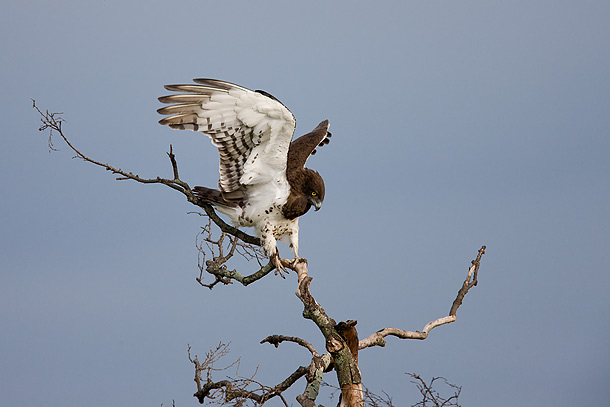
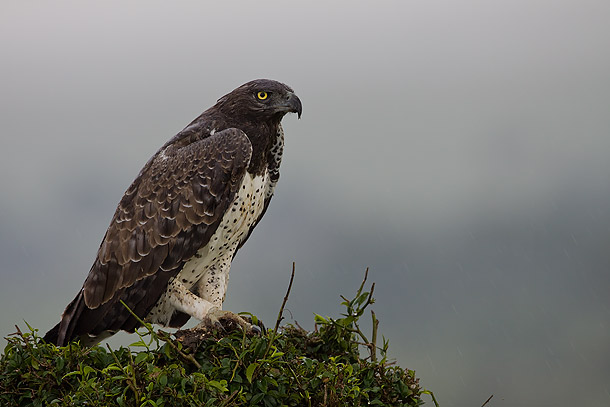
The main avian activity witnessed though was nest building. First up is a pair of Secretary birds standing on top of their partially completed nest which in turn rests atop an acacia tree.
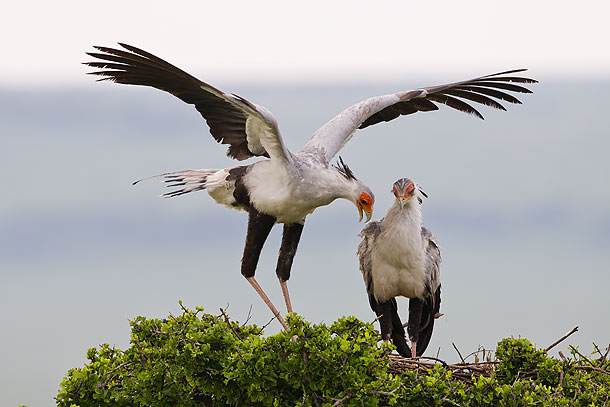
The birds would leave the nest at regular intervals to collect twigs and branches from the ground.
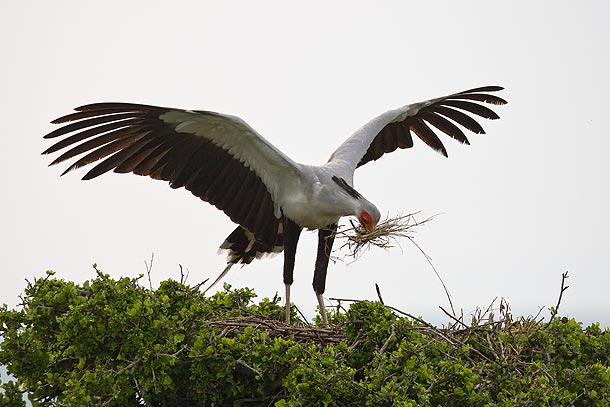
For me though, the world’s most extraordinary nest builder has to be the Weaver bird. In East Africa there are forty different types of Weavers but in the Mara, the most commonly encountered is the male Black-Headed Weaver with its distinctive yellow body, black head and red eyes.
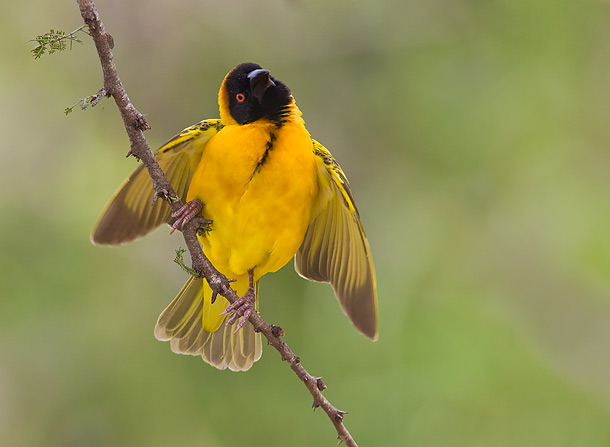
You don’t need to be much of a “twitcher” to marvel at the nest building skills of the Weaver. We watched one start from scratch and within a few hours he had almost finished the intricate structure. The birds tend to favour the hanging branches of Palm or Acacia trees as their anchor point, and these branches often overhang water, mainly because the banks of the water source usually contain the reeds that constitute the nesting material.
The birds fully live up to their name and their nest building technique involves the intricate weaving of these reeds. In the following image, the bird’s nest is at an early stage of completion. You can clearly see the elaborate weaving and knot tying that has been employed to secure the initial reeds onto the downward hanging palm.
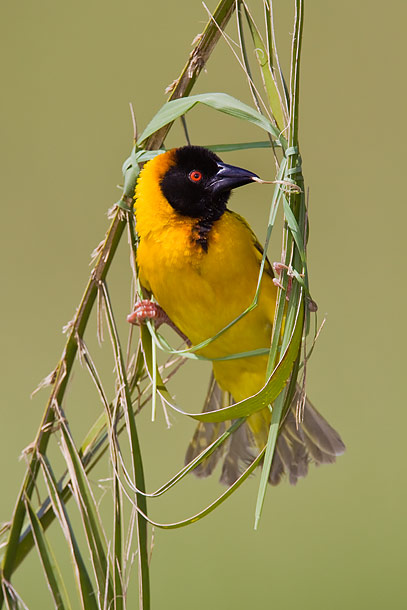
Once a reed has been secured to the nest, the Weaver will dart off to procure another reed before quickly returning.
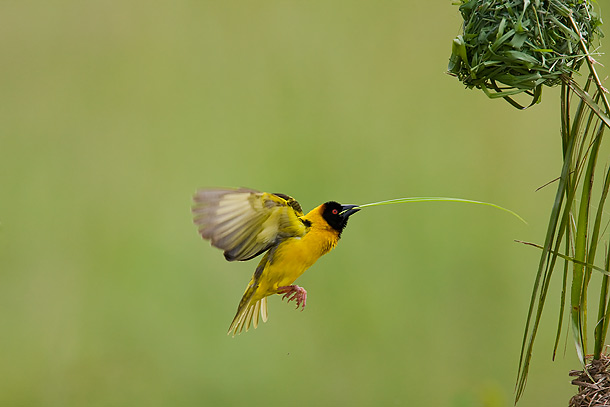
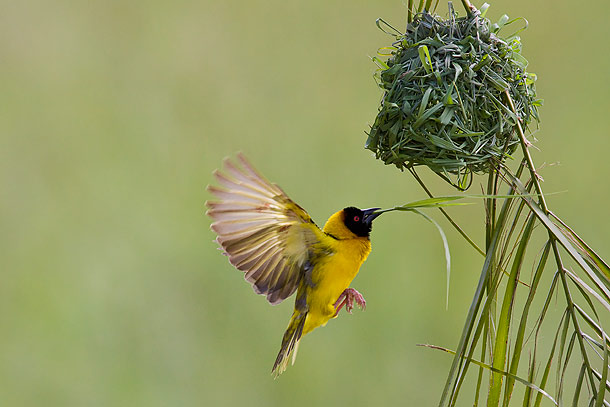
Photographing Weavers is challenging to say the least. Even at the nest, they are never still. Their heads are in constant motion and they twist and turn their bodies incessantly. It is physically impossible to follow them in flight with a long lens such is the acute speed at which they fly. The only feasible technique is to pre-focus on an object (eg the nest), switch the focusing mode to manual, lock-up the camera’s position, fight for as much shutter speed as possible by setting a high ISO (we’re talking at least 1/1,600th of second), utilize a cable release and concentrate intently on the nest, hoping the bird flies roughly parallel to the plane of the camera. At any indication of movement, press the release. You will end up with lots of pictures showing just the nest and possibly bits of cut-off Weaver. But occasionally, you will get it right as the previous two images show.
When the nest is almost complete, the Weaver will often hang from the bottom of the nest seemingly to test its strength.
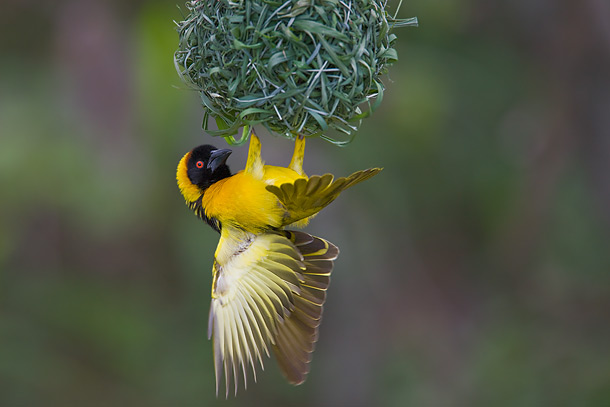
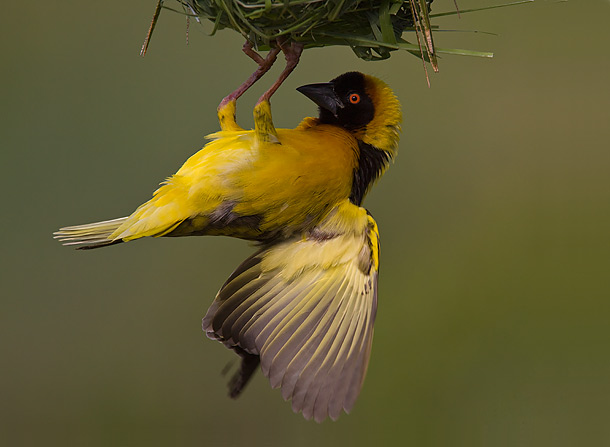
Another favorite avian species of mine is the Oxpecker. Oxpeckers share a symbiotic relationship with various grazing mammals especially Buffalo and Giraffes. The Oxpeckers are tolerated by their hosts due to their ability to remove ticks and other parasites from them.
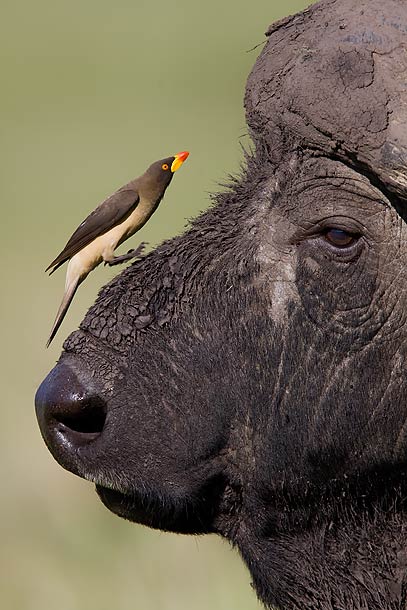
Occasionally they can also been seen opportunistically attempting to catch the numerous attendant flies that swarm around the grazers.
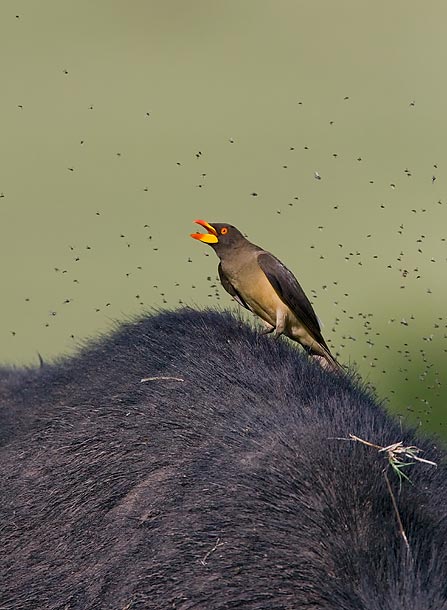
After a week in the Mara, it was time to make a brief exploratory trip to two of Kenya’s less visited parks, Amboseli and Tsavo West.
Leaving the Mara at 5am we reached Nairobi at 10am and were in Amboseli by 2pm. The roads in Kenya have been improved significantly in recent years, largely due to Mainland Chinese company construction, so travelling by road is no longer the ordeal that it used to be.
Amboseli National Park lies in the south west of Kenya adjacent to the border with Tanzania and on clear days overlooked by Mt. Kilimanjaro. Unfortunately, the snow capped peak remained blanketed with heavy cloud during my stay. The park is best known for its large elephant population, many of which are aged well over 50 years with highly impressive tusks reaching almost to the ground.
While the park may be attractive to the casual visitor, it is pretty much useless to the serious photographer. Like most parks in East Africa, no off road driving is permitted (in contrast to large parts of the Mara – I cannot stress enough that this remains a key attraction of the Mara). Moreover, unlike some of the parks in Tanzania, there simply aren’t enough roads in the park. The result is that one is forever viewing animals in the extreme distance. The only decent encounters with the elephants take place either early in the morning or late afternoon when they are making their daily journey to and from the swamp areas in the middle of the park.
The following image was actually taken outside the park which afforded us a closer vantage point. This was taken using pole cam.
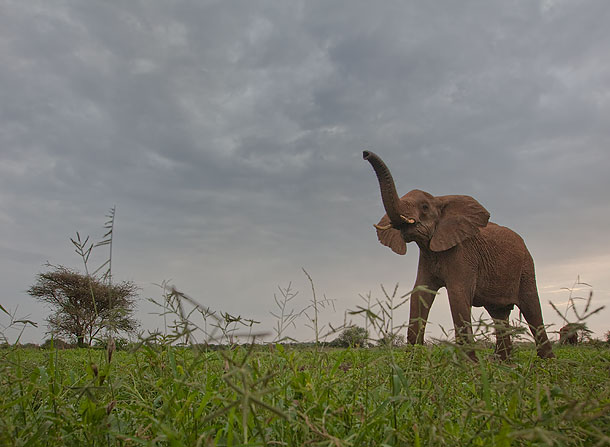
The next picture shows a herd heading into the woodlands after a day in the swamps. A three stop graduated neutral density filter was used to balance the brighter sky area with the darker foreground. Note the size of the tusks on the elephant second from left.
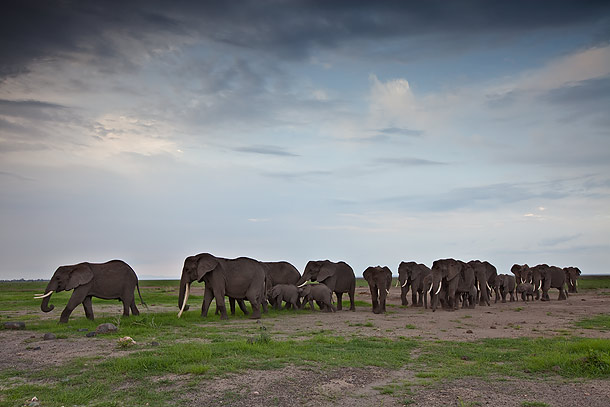
The rest of park was not a total loss and there is some decent bird life including this Red-Knobbed Coot, taken while lying down on the edge of a small lake.
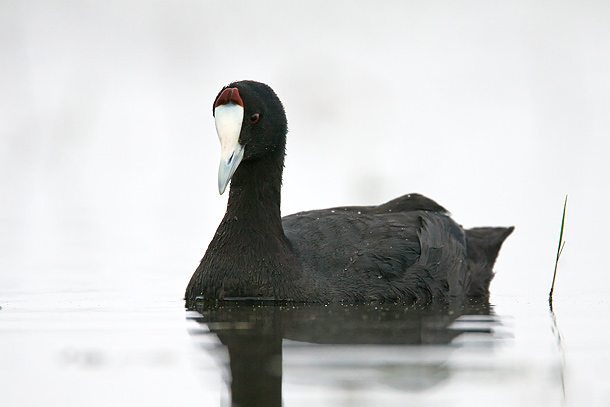
We also had an unusual encounter with a Spitting Cobra which we initially spotted in the grass in close proximity to an Egyptian Goose. At first it looked as if the Cobra would actually go for the Goose. But when the latter eventually spotted the snake it very bravely started to chase it. The Cobra briefly rose up and spread its hood but then quickly turned tail pursued by the squawking Goose. We got a real sense of how quickly a Cobra can move when it wants to and before we had reacted, it was almost up to our vehicle. For a fleeting moment it appeared that the snake might actually try to enter our vehicle. This was probably the quickest I’d ever seen Simon react as he gunned the engine leaving the snake sucking on a cloud of dust and burning rubber.
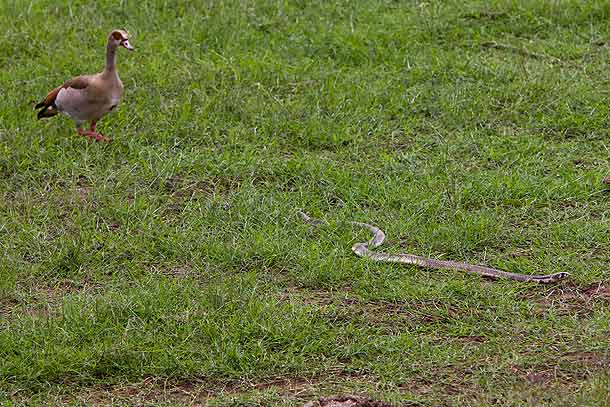
Sometimes when the game is scarce and photo opportunities scant, one has to be a little more creative and look beyond the obvious. While driving along the edge of one of the park’s lakes, I noticed a clump of reeds and their reflections in what was extremely flat light. I recognized the potential for a minimalist style image which I think turned out reasonably well.
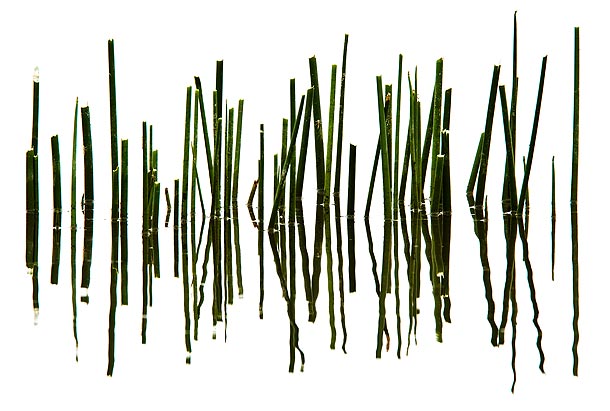
After two nights in Amboseli we made the four hour drive to Tsavo. Tsavo National Park is composed of two parks, East and West and combined, cover the largest land mass of any park in Kenya. The parks are not particularly popular with tourists, a result of the dense vegetation, absence of off road driving and relatively low density of game. But it does contain Mazima Springs and is one of the few remaining places in Kenya where with luck, it is possible to see wild dogs.
I had always wanted to see Mazima Springs after watching, many years ago, Alan & Joan Root’s truly amazing documentary on the place. Mazima is known for its clear waters and large Hippo population. Much of the documentary was filmed underwater using a variety of cages and remote cameras to provide a unique view of the life and habits of Hippos. The footage of a Python being cleaned underwater by shrimp and a remarkable episode of Hippo infanticide represent some of the greatest moments of natural history film making.
Unfortunately, Mazima was a bit of a letdown. The waters were less than clear, probably the result of recent rains and accompanying run-off into the springs. The Hippo population appeared limited and we spotted just one crocodile.
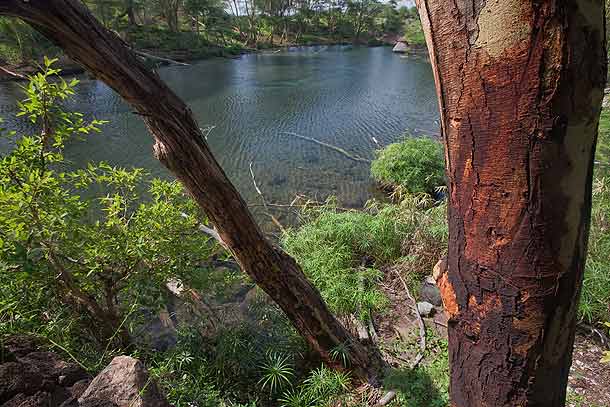
With little over half a day left in the park, I decided that rather than drive around with the slim possibility of finding Wild Dogs, I should concentrate on what was readily available. And this meant more Weaver birds, although this time a different, albeit slightly less attractive species, the Chestnut Weaver.
This time, I strived for something a little more ambitious, choosing to shot backlit. If anything, the Chestnut Weavers fly even faster and are twitchier than their Black-Headed cousins. So it was wildlife photography at its most challenging. I didn’t get much but these are three of my better attempts.
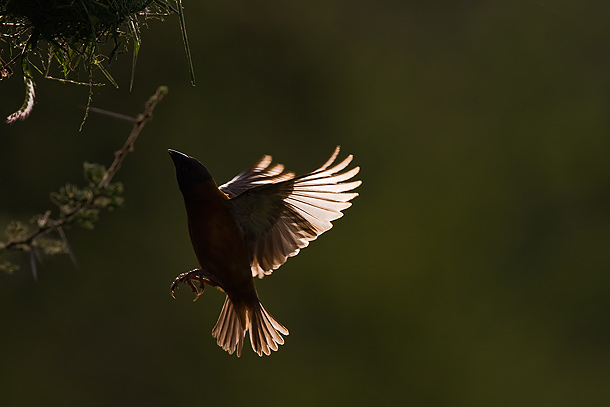
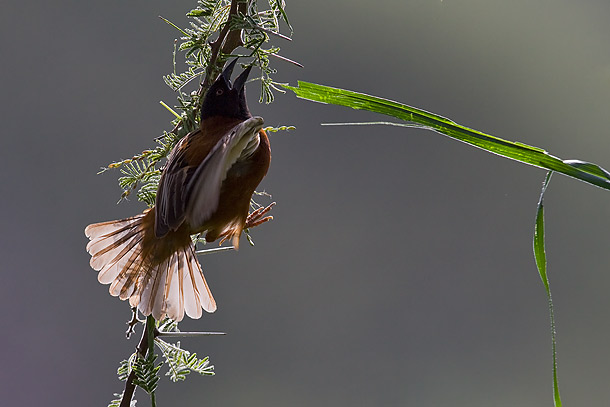
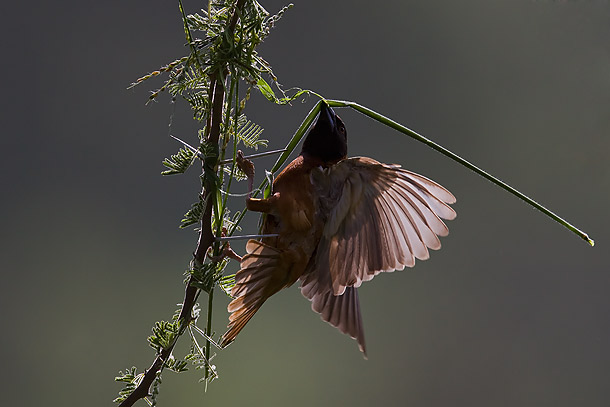
All in all, early January is an excellent time to visit Kenya although I would restrict any trip to the Mara and possibly Samburu and/or Nakuru.
I’ll post a brief trip report on Japan in a few days.
james menjo
January 28, 2010
very beautiful pictures, i realy admire them.
Jean
January 31, 2010
Amazing shots and great, vivid commentaries to bring in the actual encounters . Very kind of you to share your techniques, though I am not sure how many of us can manage to capture such shots.
jeffrey urbina
February 2, 2010
Paul –
You are doing some very fine work!
Thanks.
jeff
Andy Diamond
March 2, 2010
Superb photography and inspiring text. It will help make my forthcoming trip to the Mara even more enjoyable
Chris Wyatt
March 3, 2010
Paul,
I learned about your work from Arthur Morris’ BAA Bulletin; he was correct in that your work is exceptional. It will be difficult to select some for purchasing as you have so many great ones. I enjoy reading about your trips and going to Africa is high on my ” Bucket List”. I now have a resource for trying to plan a trip. I signed up to receive your blogs- will go back over your past ones and looking forward to your new adventures.
Thanks, Chris